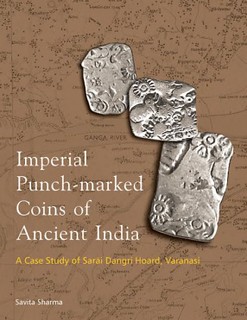
PREV ARTICLE
NEXT ARTICLE
FULL ISSUE
PREV FULL ISSUE
NEW BOOK: IMPERIAL PUNCHMARKED COINS OF ANCIENT INDIAAs noted in earlier articles, sites like
PrintAsia.com may be able to offer better deals for books
published in India, but here's a new title available from
Bagchee.com. Below is their overview for a new book on the
Imperial punchmarked coins of ancient India. -Editor
Authors (s): Savita Sharma (Author) India's indigenous coinage is rich and varied, distinguished by regional, cultural and linguistic features and representing imperial and political associations. The class of coins that finds frequent mention in ancient Indian epigraphs and literary sources is the karsapana. Karsapana, also known as Purana or Dharana, are the punch-marked coins which were in circulation throughout ancient India. Many hoards of silver punch-marked coins have been located in sites all over the country. Its widespread availability suggests that it was a standard medium of exchange from about the 6th century BCE. Every new discovery of a treasure-trove has something new to add to the mine of knowledge extensively compiled by scholars. An earthen pot containing 333 ancient silver punch-marked coins was found in July 1997, from Sarai Dangri village, Varanasi while digging the foundation of a primary school building. These coins were handed over to Bharat Kala Bhavan, Banaras Hindu University, Varanasi in 1998 by the District Magistrate of Varanasi. The study of these coins forms the subject matter of this volume. Coins in this hoard, classified as Imperial Karsapana, are datable to circa 4th century to 2nd century BCE, comprising seventy-six varieties. The volume is divided into four parts: Part I commences with an explanatory introduction outlining the importance of this hoard. This also serves as a comprehensive backdrop of the present study; Part II covers classification and cataloguing. Here an attempt has been made to refer to most of the published material and views, with drawings and illustrations of obverse and reverse of each variety in tabulated form; Part III incorporates the observations on the present study and includes tables of the symbols in detail, as well as a brief description on extra-marks and half-coins; Part IV comprises appendices on weights and chemical analysis based on some coins of the hoard, an EDS Report, dispersal of coins, list of hoards and a bibliography. The volume should be of immense help to students and scholars of numismatics. They will gain a deeper insight and understanding of Indian numismatics in general and about this remarkable series of silver punch-marked coins in particular. To read the complete article, see: Wayne Homren, Editor The Numismatic Bibliomania Society is a non-profit organization promoting numismatic literature. See our web site at coinbooks.org. To submit items for publication in The E-Sylum, write to the Editor at this address: whomren@gmail.com To subscribe go to: https://my.binhost.com/lists/listinfo/esylum All Rights Reserved. NBS Home Page Contact the NBS webmaster 
|
